U.S. Department of Transportation
Federal Highway Administration
1200 New Jersey Avenue, SE
Washington, DC 20590
202-366-4000
Federal Highway Administration Research and Technology
Coordinating, Developing, and Delivering Highway Transportation Innovations
| SUMMARY REPORT |
| This summary report is an archived publication and may contain dated technical, contact, and link information |
|
| Publication Number: FHWA-HRT-14-059 Date: August 2014 |
Publication Number: FHWA-HRT-14-059 Date: August 2014 |
J. Gregory McDaniel,
Boston University
J. Gregory McDaniel’s presentation focused on versatile onboard traffic-embedded roaming sensors (VOTERS) that use vehicles of opportunity (VOO) as inspection data platforms. The research project that McDaniel described in the presentation has been ongoing for 5 years at Northeastern University.
McDaniel explained how the VOTERS project uses a test van that monitors road materials in real time. As shown in figure 1, the van is equipped with the following: GPS, camera, directional microphone behind the left rear tire, laser height sensor, dynamic tire pressure sensor (DTPS), rear-axle accelerometer, a five-sensor surface millimeter-wave radar array, and a power supply. The van also features a portable real-time monitoring system, control station, and data acquisition and processing station.
 |
| Figure 1. The versatile onboard traffic-embedded roaming sensors (VOTERS) test van. |
McDaniel provided an overview of how the VOTERS test van measures the surface waves in the road that carry information about subsurface conditions. Waves in the tire wall carry information about the road surface from road and tire interaction. A key point that McDaniel noted during the presentation was that the surface waves in the road have very large wavelengths that reach the width of the entire road. It is therefore not necessary to measure exactly over an area with a subsurface issue to detect the issue.
Specific challenges noted for these measurements include wind, vehicle vibration, and acoustic resonances. Key resonances to consider include the following:
Principal Component Analysis
McDaniel explained to workshop participants how mounting the directional microphone behind the rear tire eliminates wind noise. Processing data by using the principal component analysis (PCA), developed for this purpose, filters out the remaining noise. The vehicle speed must be known to complete the PCA analysis to output the mean texture depth (MTD). This method has been validated, and calibration can be performed by driving on a road with a known MTD. An exterior microphone can also be used to find the MTD at three different vehicle speeds with this system.
Dynamic Tire Pressure
During the presentation, McDaniel noted that the DTPS concept measures the change in internal air pressure through a sensor mounted on the valve stem. This sensor can be added to any tire, powers itself, wirelessly transmits data, and will sample at 40 kHz. If the car is not moving, the sensor measures zero. He also noted the DTPS has been validated against an accelerometer on the ground.
McDaniel put forward to workshop participants several advantages to using DTPS, as follows:
As shown in figure 2, if the DTPS is paired with an axel accelerometer, the impedance of the road can be measured to detect subsurface damage. This can also be performed at typical traffic speed, and the difference between the body of the car moving up and down and bumps in the road can be differentiated. McDaniel noted that this method can provide reliable correlations to a longitudinal road profile, pavement condition index, and international roughness index.
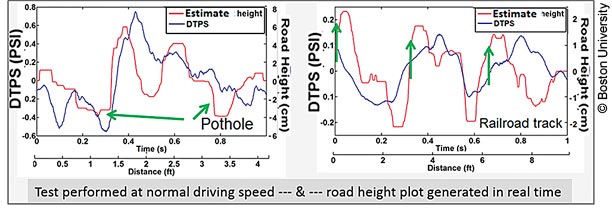 |
| Figure 2. Longitudinal road profile. |
Sensing Surface Waves
For an acoustic-sensing method for detecting surface waves, McDaniel told workshop participants that it is recommended to put the microphones as close to the ground as possible (without touching the ground). This method includes the use of a mechanical excitation cart to create the waves. Because the signal-to-noise ratio is very poor when using this method, an iterative wave-fitting method algorithm is currently in development. This algorithm estimates the complex number of the wave, and an important output of this algorithm is the decay rate. McDaniel also explained that the decay rate contains information on the properties of the material and whether there could be subsurface damage.
Conclusion
In summary, McDaniel explained that all the methods presented are based on physics. He also highlighted that exploiting physics can provide significant advantages in noisy environments.
Questions
Following the presentation, McDaniel responded to the following question from a workshop participant:
McDaniel confirmed that this is not the case because the time window during which the DTPS is used is very small, and the calculation assumes no transfer of heat energy.
John S. Popovics,
University of Illinois
John S. Popovics’ presentation focused on cost-effective and accurate inspection of concrete transportation infrastructure. Popovics presented specific methodology to workshop participants, including scanning impact-echo for delamination detection and air-coupled ultrasonic surface wave characterization of defects.
Scanning Impact-Echo for Delamination Detection
Popovics began with an explanation of the impact-echo technique, a test based on impact resonance. The material is interrogated with a hammer, or ball drop, and the material responds by “ringing” in different stretch or flexural resonance modes, or a combination of modes. This allows for the identification of defects.
Popovics explained that flexural modes are easy to detect acoustically, and stretch modes are difficult to detect. In accordance, this method works well for near-surface delamination because it is characterized by flexural modes; however, a problem with the current methodology is that it requires detailed interrogation of the material and cannot be performed at highway speeds.
Popovics proceeded to describe the development of a contactless echo-scanning system that uses a microphone array. This is an inexpensive method that uses a rugged test setup. As shown in figure 3, a hand-driven impact produces the needed excitation. Popovics also provided experimental results from a static system and a platform that moves at walking speed. Modal analysis of the results produces detailed images for fixed-testing systems; however, this type of analysis is not practical for bridge decks, because the goal is to collect data with a moving platform.
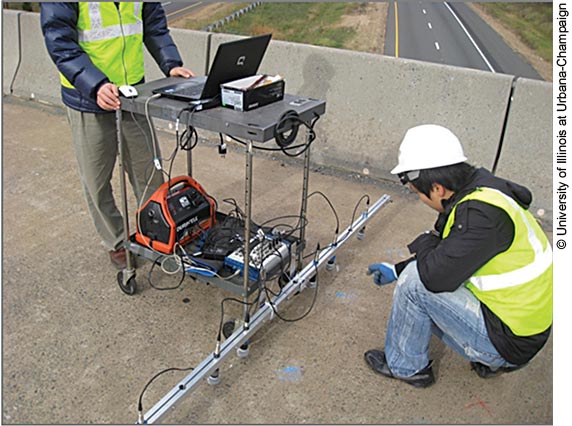 |
| Figure 3. The contactless impact-echo scanning system. |
To analyze data from a moving platform, the system collects individual spectral signals that are stacked and mapped. A four-dimensional (4D) plot can provide a view of a thickness-stretch mode, as shown in figure 4. Popovics suggested that the use of transparency simplifies the interpretation and clearly indicates where defects occur. For example, low-amplitude data are transparent (indicating no defect) and high-amplitude data are opaque (indicating a defect). This is considered a very effective way of filtering data to view defects, and when validated against other more personnel- and time-intensive methods, the 4D image produces the same end result.
Popovics also provided an overview of testing the nonmoving platform on an active bridge. The project research team collected data on the bridge deck in 90 minutes with a 100-percent hit rate. This meant that everywhere the analysis indicated there was a delamination, one was found. The presence of delamination at a subset of locations was determined from extracted core samples. Popovics noted that this method did not require filtering of signals to remove noise from active traffic, even though the roads were being heavily used during the measurement.
Air-Coupled Ultrasonic Surface Wave Technique
During his presentation, Popovics also covered the concept of using air-coupled ultrasonic waves to measure surface waves. This could be an inexpensive technique, because each sensor set (consisting of a transducer and receiver pair) costs about $70. The propagation source and receiver sensors can also be applied from a range of heights from the surface, but in this example they were 5 cm (2 inches).
This method allowed for the introduction of a fully contactless scanning frame, as shown in figure 5. According to Popovics, one of the most important features of a contactless scanning frame is the signal consistency. This allows for repeatability, regardless of surface roughness. In addition, this system can also measure energy attenuation to monitor surface distress. Popovics explained that using Lamb waves (plate waves) as the signal allows for a new method to detect the presence of delamination. By using the multichannel analysis of surface waves approach—involving one sender with many receivers—a delamination can be identified very quickly, with potential for eventual application at highway speeds.
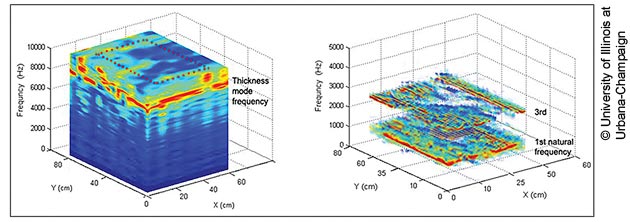 |
| Figure 4. Effective presentation of impact-echo data with transparency. |
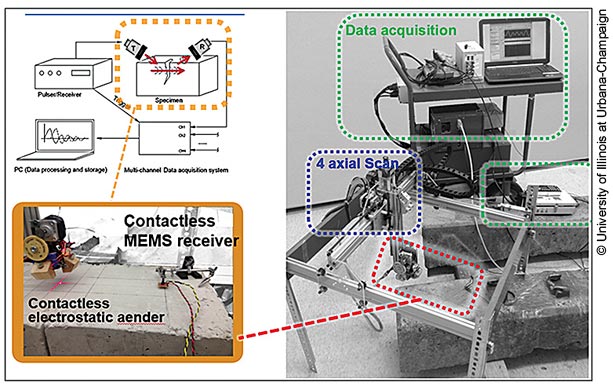 |
| Figure 5. Fully contactless scanning system. (PC = personal computer, MEMS = microelectromechanical system.) |
Questions
At the end of the presentation, Popovics responded to the following question from a workshop participant:
Popovics confirmed that, although the location of flaws with flexural resonances can be detected, the exact flaw depth is unknown.
Lee Mixon, Mixon Hill
Lee Mixon’s presentation focused on how agencies manage and operate systems and data. Mixon explained that agencies need highly accurate and reliable information. This type of information includes baseline information characterizing the assets, current condition information, information that puts the agency in control of managing and operating the infrastructure, and also systems that give the agencies information, control, and the ability to deliver automated results. The ultimate goal is to provide enough information so that agencies know what needs to be fixed and what materials are needed without traveling to each site first.
Data Uses Analysis and Processing
Mixon highlighted a project performed for Michigan Department of Transportation (MDOT), which included connected-vehicle data use, increased data sharing, and support performance management. The data uses analysis and processing (DUAP) system collects a large volume of data, including weather, infrastructure, mobile, fleet, freight, and construction data in a map-based system, as shown in figure 6.
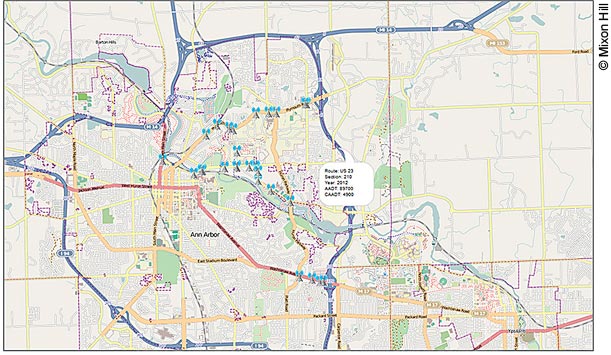 |
| Figure 6. Highway Performance Management System traffic data. |
Researchers for the project queried all organizational functional areas and subareas to understand and prioritize the data needs. In addition, Mixon reminded workshop participants of the importance of data distribution and the concept of “collect once, use many” (shown in figure 7). During the presentation, Mixon highlighted that multiple efforts to obtain the same information occur far too often. The DUAP system includes pavement, traffic arterials, weather, maintenance-user-delay cost, incident management, construction, financial, and other information.
Vehicle-Based Information and Data Acquisition System
Mixon explained that the vehicle-based information and data acquisition system (VIDAS) collects data as employees drive maintenance and supervisory vehicles. VIDAS then transmits the information in real time and processes and updates data in the user interface. Sensors that are used in this system include weather, accelerometery, LIDAR, and radar. The system is scalable to allow for growing data collection needs.
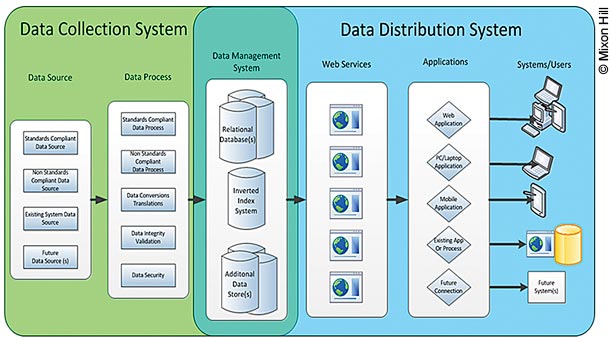 |
| Figure 7. Data uses and analysis and processing proposed system. |
Following the presentations, workshop participants and presenters participated in a question-and-answer session. The participant questions and presenter responses are summarized below.
Presentation 1: What Can We Learn From Vehicle Noise and Vibration?
The research team does not get to choose the source, although the team members would like to try a studded or solid tire. Chain drag was tried, but there were safety concerns. In addition, each tire is a source and receiver at the same time. The research team is working on an array to have four inputs and four outputs to capture any defect between the four tires.
The thickness of materials has been determined, and the differences in subsurfaces can be detected by using the DTPS, although it has not been codified at this point. When you start having delamination in roads, resonances occur, and that can be seen in the dynamic tire pressure.
It is possible to explore 91 cm (36 inches) with a standard tire.
At the surface, it is possible to differentiate between different types of defects. Examples of detectable defects include potholes, cracks, and patches. In addition, video can provide visual confirmation.
There is a calibration station, but this is in the research stage, so calibrations must be done and then compared to the current condition. Both passenger vehicles and dedicated vehicles could be used in the future.
Presentation 2: Seeing Below the Surface Using Acoustic-Based Sensing and Imaging
The microphones are available off the shelf. The brand is SHURE, the model is SM58, and the cost is approximately $80. The microelectromechanical system sensors are off the shelf, but the circuitry is not included and must be set up. These sensors produce analog signals.
The impact-echo technique likely will never occur at highway speed, but it does work very well around 8–16 km/h (5–10 mi/h).
There are geometric constraints. A closely spaced pair is used, and they interrogate specific places.
There is overlap that would be good to explore.
Presentation 3: Using Vehicles as Sensors for Roadways, Bridge, and Infrastructure Health Monitoring in Connected Vehicles.
VIDAS is a data acquisition system (DAS) and the goal for it is to create a set of vehicles that have a DAS that can have sensors added to it. The DAS must have a configuration data manager, use standard code, and when new sensors are added, they must be evaluated offline before being added to the overall platform.
An alternative approach would be to have each sensor coupled with its own processing power. Multiple computers could run on different operating systems, with the same positioning information that could communicate with each other through one main controller that manages the systems. Data could be automatically uploaded when the network is detected, although certain systems (e.g., GPR) could not fit in that system because of extreme DAS requirements.
It can vary in sizes. The components are off the shelf, but multiple systems are distributed. In addition, when thinking about outfitting passenger vehicles, another sensor will need to be added on to sense subsurface.
General Questions
Research needs must be defined and communicated with manufacturers for them to accept the ideas and make them possible. Combining research efforts with manufacturers has increased over the past few years.